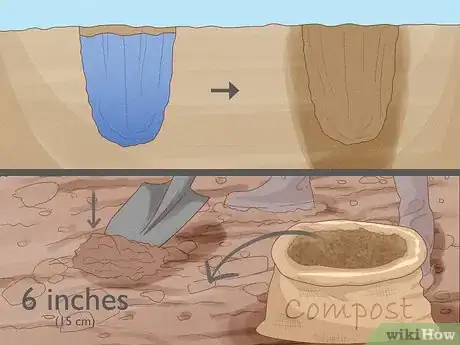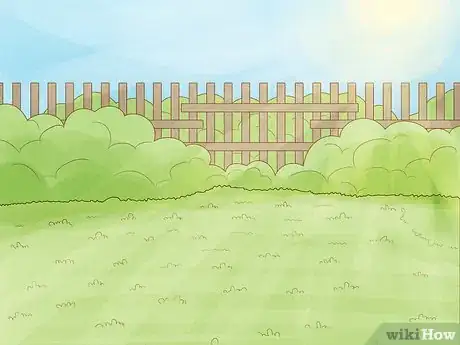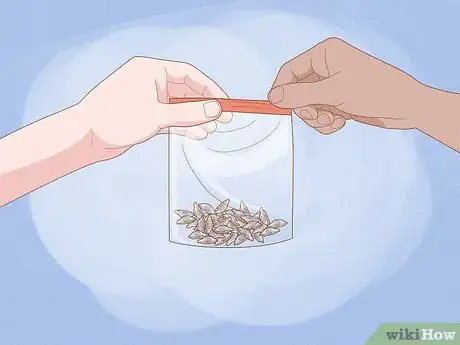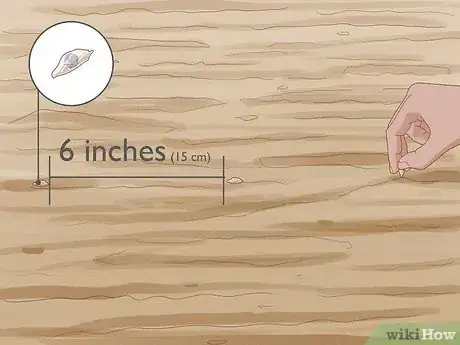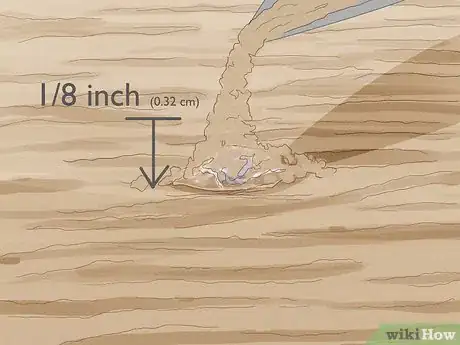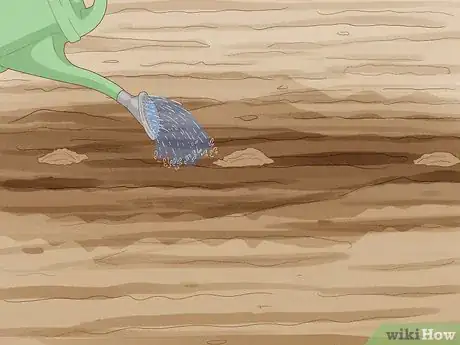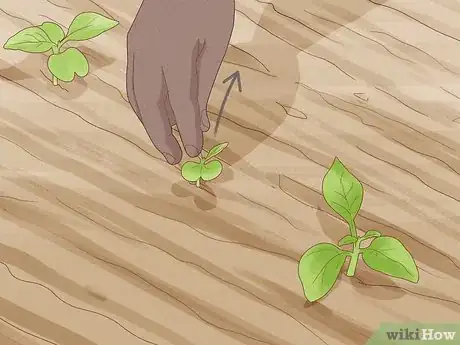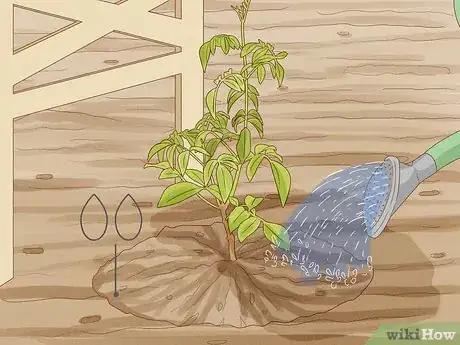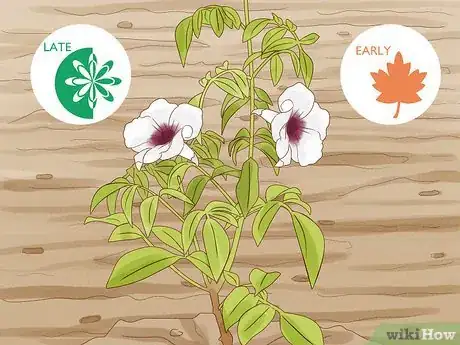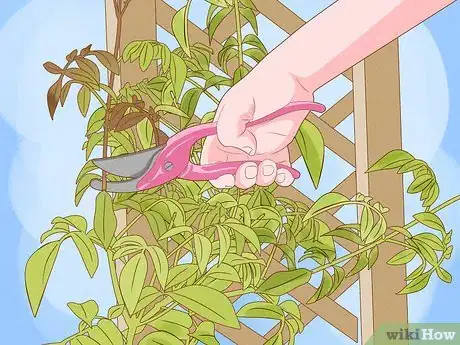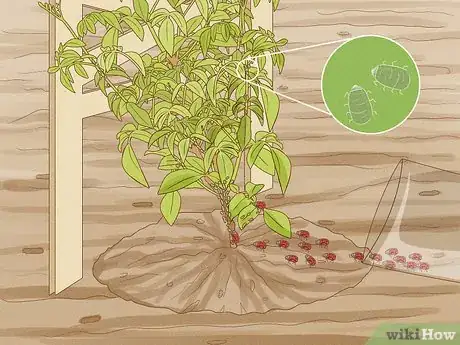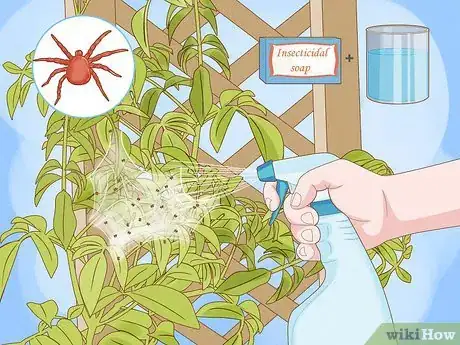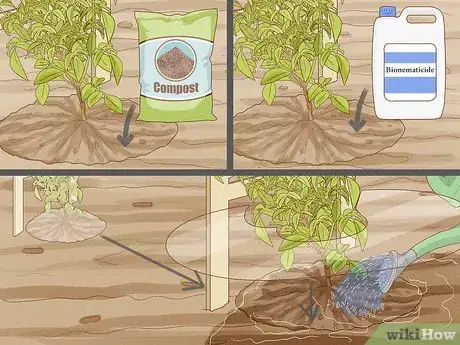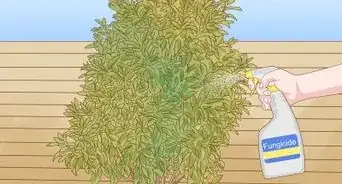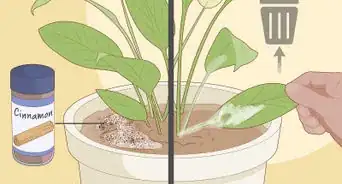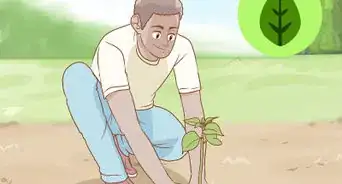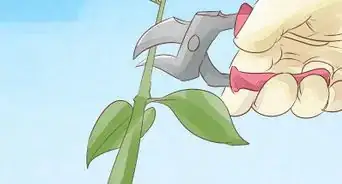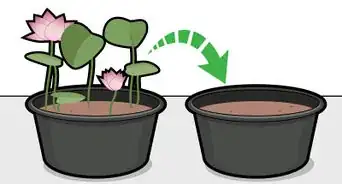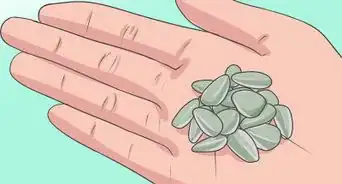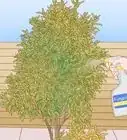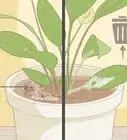This article was co-authored by Lauren Kurtz and by wikiHow staff writer, Sophia Latorre. Lauren Kurtz is a Naturalist and Horticultural Specialist. Lauren has worked for Aurora, Colorado managing the Water-Wise Garden at Aurora Municipal Center for the Water Conservation Department. She earned a BA in Environmental and Sustainability Studies from Western Michigan University in 2014.
There are 8 references cited in this article, which can be found at the bottom of the page.
This article has been viewed 43,578 times.
Pandorea, also known as the bower vine or Pandorea jasminoides, is a native Australian climber with pretty trumpet-shaped flowers. It has tropical foliage that is beautiful even when it’s not in bloom. You can grow pandorea in containers or directly in your garden.
Steps
Selecting a Planting Site
-
1Choose a site with well-draining soil. Observe the area where you intend to plant pandorea after a rainstorm or watering heavily. If there are pools of water after an hour or so, the soil isn’t well-draining. To amend your soil, dig up the top 6 inches (15 cm) of soil and mix in a light layer of sand, compost, or dead leaves.[1]
- If you’re planting pandorea in a container, choose a loamy soil so it has good drainage.
- Pandorea does well in acidic, neutral, and alkaline soil.
-
2Select a spot with full sun. Choose a spot in your lawn or garden that gets sunlight for the majority of the day. A spot that is shaded for less than 3 hours a day will also work, but more shade than that can stunt the plant’s growth and prevent it from blooming.[2]
- If you’re growing pandorea indoors, place the container near a south- or west-facing window.[3]
Advertisement -
3Plant pandorea in the springtime. If you’re planting pandorea outdoors, wait until the danger of frost has passed. To find the average frost dates for your area, do an online search or check your local weather app.[4]
- If you’re growing pandorea indoors, you can plant it at any time of year.
Planting Pandorea
-
1Obtain pandorea seeds. If you have a friend or neighbor that grows pandorea, you could ask them for seeds from their plant. Alternatively, you can purchase pandorea seeds from a nursery or online.
- Seeds can be collected from the pods of an existing plant after the flowers die at the end of the fall season.
-
2Sow the seeds 6 inches (15 cm) apart. When you’re ready to plant the pandorea, keep in mind that this is a fast-growing vine. It spreads quite a bit, so you should space the seeds about 6 inches (15 cm) apart.[5]
- Alternatively, you can plant 2-3 seeds in a large pot.
-
3Cover the seeds with 1⁄8 inch (0.32 cm) of soil. The seeds need light to germinate, so don’t cover them with too much soil. Press the seeds lightly into the soil with your finger, then cover them with about 1⁄8 inch (0.32 cm) of soil.[6]
-
4Soak the seeds after planting them. To ensure the seeds germinate and take root, you need to water them immediately after planting. Thoroughly soak the seeds and surrounding soil with water. Pandorea seeds will germinate within 6-21 days.
-
5Pull the weaker plants after the seedlings emerge. Once the pandorea begins to grow, inspect the plants. Those that are smaller, thinner, and weaker can be removed. Leave only the healthiest vines.[7]
Caring for Pandorea
-
1Provide a climbing support for the plant. Because pandorea is a vine, it needs something to attach to so it can grow vertically. Unless you want it to spread across your garden and take over, you should provide a trellis or climbing posts for the pandorea.[8]
- Once the vines begin to grow, wrap them around the trellis or climbing pole. They will then begin to grow and climb upward, rather than outward.[9]
-
2Keep the soil moist. It’s important to check the soil around the Pandorea several times a week. If it looks or feels dry, water the soil until it is moist but not soggy. Depending on your location and soil composition, you may need to water the pandorea every day or once a week.[10]
- In the winter, you can water less frequently. Check the pandorea once per week and water it if the soil is dry.
-
3Expect the plant to bloom from late spring to early fall. Pandorea plants develop beautiful trumpet-shaped flowers. Usually, they have white petals and pink throats. Though these flowers are unscented, they are a beautiful addition to your home or garden.[11]
-
4Prune pandorea after it flowers. If you want to shape or trim the pandorea, wait until late fall when it is done blooming. Use sterilized pruning shears to snip off dead or diseased vines. You can also shape the pandorea as you like or cut it back to reduce its size.[12]
- When pruning, cut the vines back to a shoot or bud. If you’re removing damaged or diseased parts of the vine, cut it back far enough that only healthy tissue remains.
Troubleshooting Problems
-
1Introduce ladybugs if you have an aphid infestation. If you notice aphids, which are small, pear-shaped bugs, on the plant, you can get rid of them without using harsh chemicals. Purchase ladybugs from your local gardening center and gently shake them from the bag onto the vines. They will stay with the plant until all the aphids have been eaten.[13]
- Usually, ladybugs come in packages of around 1,000, which should be more than enough to handle your aphid problem.
- If you’re growing pandorea indoors, use an insecticidal soap as per the package directions to get rid of aphids.
- Another way to reduce aphids is to spray down the plants with a strong stream of water. Do this once every 2-3 days.
-
2Get rid of red spider mites with an insecticidal soap. Your pandorea may attract red spider mites, which are small, yellow-green bugs, contrary to their name.[14] If you have spider mites, you can eradicate them with an insecticidal soap, available from your local gardening center. Spray the vines with the insecticidal soap as per the directions on the package.[15]
- Be sure to select an insecticidal soap formulated for use on pandorea. Ask a sales associate for help if you have any questions.
- You may need to spray the plants every 2-3 days until the infestation is gone.
-
3Control nematodes with a multifaceted approach. Nematodes are small worms that eat the roots of plants. If you have sandy soil, you’re more like to have nematodes.[16] Nematodes are notoriously difficult to eradicate, but you may be able to control the problem with a variety of techniques.[17]
- Amend the soil by adding organic material like manure and compost to limit the damage done by the nematodes.
- You can also apply bionematicide on a regular basis to paralyze the nematode eggs so they don’t hatch.
- Use solarization to treat the soil after relocating the plant. Work the area with a hoe or tiller, then water the soil until it is moist. Cover the area with clear plastic, and let the heat destroy the nematodes by leaving the area covered for up to 6 weeks.
Community Q&A
Did you know you can get answers researched by wikiHow Staff?
Unlock staff-researched answers by supporting wikiHow
-
QuestionDo the flowers smell much?
 wikiHow Staff EditorThis answer was written by one of our trained team of researchers who validated it for accuracy and comprehensiveness.
wikiHow Staff EditorThis answer was written by one of our trained team of researchers who validated it for accuracy and comprehensiveness.
Staff Answer wikiHow Staff EditorStaff Answer
wikiHow Staff EditorStaff Answer -
QuestionCan I over winter in a greenhouse?
 NinoxTop AnswererYes, pandorea needs warmth to grow. You'll have to bring it in a greenhouse if you live in a cold region.
NinoxTop AnswererYes, pandorea needs warmth to grow. You'll have to bring it in a greenhouse if you live in a cold region. -
QuestionI have bought a pandorea jaminoide. It is all twined round a long cane. Do I undo the stems and let them be free, or leave them around the cane?
 NinoxTop AnswererPandorea is a climbing plant, so the best condition for the plant is around a cane or another structure where it can climb.
NinoxTop AnswererPandorea is a climbing plant, so the best condition for the plant is around a cane or another structure where it can climb.
References
- ↑ https://www.anbg.gov.au/gnp/interns-2014/pandorea-jasminoides.html
- ↑ https://www.anbg.gov.au/gnp/interns-2014/pandorea-jasminoides.html
- ↑ https://www.rhs.org.uk/Plants/90149/Pandorea-jasminoides/Details
- ↑ https://www.anbg.gov.au/gnp/interns-2014/pandorea-jasminoides.html
- ↑ https://www.southernliving.com/plants/pandorea
- ↑ https://www.sunset.com/garden/garden-basics/sowing-seeds
- ↑ https://www.southernliving.com/plants/pandorea
- ↑ https://floridata.com/Plants/Bignoniaceae/Pandorea+jasminoides/216
- ↑ http://www.nola.com/homegarden/index.ssf/2009/07/training_garden_vines_right_th.html
- ↑ https://floridata.com/Plants/Bignoniaceae/Pandorea+jasminoides/216
- ↑ https://www.southernliving.com/plants/pandorea
- ↑ https://www.southernliving.com/plants/pandorea
- ↑ https://www.rhs.org.uk/Plants/90149/Pandorea-jasminoides/Details
- ↑ https://www.rhs.org.uk/Plants/90149/Pandorea-jasminoides/Details
- ↑ http://www.guide-to-houseplants.com/spider-mites.html
- ↑ https://floridata.com/Plants/Bignoniaceae/Pandorea+jasminoides/216
- ↑ http://edis.ifas.ufl.edu/ng005
